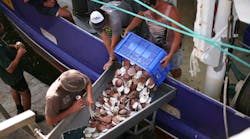Sarufutsu village in the far north of Japan’s northernmost island is the nation’s richest village, thanks to a bounty of scallops pulled from the Sea of Okhotsk.
The village -- which is closer to the Russian island of Sakhalin than Tokyo -- boasts some of the highest average incomes of any town in Japan, thanks to the earnings of some of the fishermen. But the new scallop factory isn’t running at full capacity because it can’t get enough workers for lower paying but important jobs.
It’s a problem for the economy as a whole because it shows that some industries may not survive as the population ages and shrinks, even if they are profitable.
The scallops from the nearby waters are dried and then mostly exported to Hong Kong and elsewhere as a premium ingredient in Chinese food. By value, scallops are the biggest international export from Hokkaido. But the workers in the factory are mostly older women, and in about seven or eight years, there won’t be any more Japanese working there, according to Koichi Kimura, an executive of the fishing cooperative that runs the facility.
"If we wanted to we could run 24 hours a day and triple production," says Kimura. "But we would need more than 100 new people for that."
The village’s population isn’t shrinking, but it’s flat, and while the factory employs 19 Chinese trainees among its 90 staff, it can’t legally increase their numbers without adding more Japanese employees. So the village authorities are trying to encourage people to move to the town.
For the past three years the village has run tours to bring people from other parts of Japan to check it out as a possible place to live, and also appointed the chef of a Tokyo restaurant that uses their scallops as a tourism ambassador.
Income Disparity
But it’s a hard sell given that work in the factory is seasonal and wages are low.
While the 250 or so fishing cooperative members who work the boats earn good money, pushing up the average, those employed in the factory earn minimum wages, and it’s only open for seven months a year. The factory is closed during the winter, when temperatures in the area go below minus 20 degrees Celsius (minus 4 degrees Fahrenheit).
Without better pay and conditions, it will be hard to attract people to live in the area, but the cooperative doesn’t think it can dramatically increase wages.
"Young Japanese people aren’t interested if we just raised pay a little," says Kimura. "If we were to double or triple wages, we could attract workers, but we wouldn’t be able to make ends meet."
While economists and the Bank of Japan point to the shrinking population as an opportunity for companies to increase automation and productivity, not all jobs can be done by machines. The 2.4 billion yen (US$22 million) new factory was opened in April 2016 with new machinery, but it still requires workers.
They might have to consider moving the factory, according to Hokkaido University Professor Atsushi Miyawaki, who studies government policy.
"Even with the cost of capital falling so low, there just isn’t new investment," he said. "In a few places, the economic story the BOJ tells may work, but it’s impossible here in Hokkaido."
By Masahiro Hidaka




